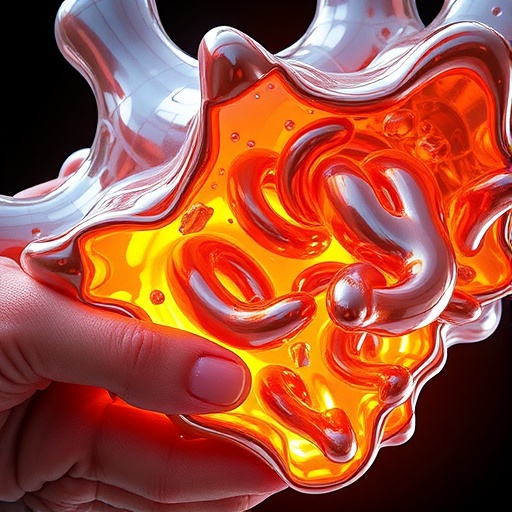In an era where the understanding of soil behavior under various chemical influences is becoming increasingly critical, a recent groundbreaking study by Wang, Xu, and Qian published in Environmental Earth Sciences sheds new light on the permeability response of remolded loess to varying concentrations of aluminum chloride (AlCl₃). This research opens a door to advanced environmental management and geotechnical engineering applications, challenging existing paradigms related to soil chemistry interactions and fluid dynamics.
Loess, a fine, silt-sized sediment, is known for its unique physical and mechanical properties, which make it a prominent subject in soil science. It is particularly widespread in arid and semi-arid regions and serves as a foundation material in construction and agriculture. The permeability of loess, or its ability to transmit fluids, is a crucial property influencing groundwater flow, contaminant transport, and soil stability. However, the complex factors that govern how loess permeability reacts to chemical alterations have largely remained elusive until now.
The researchers embarked on an experimental journey to quantify how remolded loess permeability changes with different concentrations of AlCl₃ solutions. This choice of chemical agent is significant because aluminum ions are known to impact clay minerals and soil texture by inducing flocculation or dispersion of particles. By methodically varying the concentration of aluminum chloride, the team was able to observe a fascinating and previously unreported nonlinear response mechanism.
What makes this study truly remarkable is the clear demonstration that the permeability of loess does not merely decrease or increase monotonically with rising AlCl₃ concentration, as some prior models might suggest. Instead, the research reveals a complex pattern of permeability evolution that is closely tied to the microstructure transformations within the soil matrix caused by aluminum ions interacting with mineral surfaces and pore water chemistry.
Detailed microstructural analyses in the study showed that at low to moderate AlCl₃ concentrations, the aluminum ions promote aggregation of soil particles through cation bridging and charge neutralization, effectively reducing pore sizes and limiting water flow. Conversely, at higher concentrations, an unexpected phenomenon occurs where the increased ionic strength leads to particle dispersion due to osmotic and electrochemical effects, slightly reopening pore spaces and partially restoring the permeability.
This nuanced permeability response has profound implications for groundwater modeling, especially in regions where soil contamination with aluminum salts is prevalent either naturally or due to anthropogenic activities. Understanding these subtle shifts in soil permeability can prevent inaccurate predictions of contaminant migration and improve soil remediation strategies.
From a technical perspective, the study’s rigorous approach involved the use of remolded loess samples subjected to controlled laboratory permeability tests under various AlCl₃ solution concentrations. The researchers utilized advanced imaging techniques including scanning electron microscopy (SEM) to verify the microstructural alterations. Additionally, zeta potential measurements provided key insights into surface charge changes that regulate particle interactions, linking physicochemical conditions to observed hydraulic behavior.
Importantly, the team emphasized the role of soil fabric and particle orientation changes induced by aluminum ions, which subsequently influence the connectivity and tortuosity of the flow pathways. This aspect of soil mechanics often receives less attention but is critical for interpreting permeability variations on a fundamental level.
One of the most eye-catching contributions of this work is the proposed conceptual model of permeability response which integrates soil chemistry, mineralogy, and pore-scale hydraulics. This comprehensive understanding marks a substantial advancement beyond traditional hypotheses that treated chemical effects on soils in a more simplified or isolated manner.
The discovery invites a revision of current environmental risk assessments, particularly in loess-dominated landscapes that are vulnerable to saline intrusion or aluminum contaminant inputs. It also provides engineers with a better toolkit for designing foundation supports, managing irrigation, and planning land reclamation where chemical loading on soils is inevitable.
Moreover, the interdisciplinary nature of the study unites principles from soil physics, environmental chemistry, and geotechnical engineering, promoting a holistic approach to soil permeability research. The implications can extend to other fine-grained sediments beyond loess, encouraging parallel investigations in different contexts.
By illustrating how remolded loess behaves dynamically at varying chemical regimes, the study opens opportunities for tailored soil treatment processes. For instance, controlled dosing of aluminum salts might be employed to manage soil permeability purposefully in groundwater conservation or contaminant containment applications.
Future investigations are anticipated to build upon this novel response mechanism by exploring the impacts of additional chemical species and environmental conditions such as pH, temperature, and competing ions. Such research will further refine models predicting soil behavior under realistic field scenarios.
In conclusion, Wang and colleagues’ pioneering work fundamentally enriches our comprehension of soil permeability modulation by aluminum chloride. Their findings challenge researchers and practitioners to reconsider long-held beliefs and underline the complexity of soil-fluid interactions at the microscopic scale. This enhanced understanding is likely to catalyze innovative approaches in environmental protection, sustainable construction, and resource management worldwide.
Subject of Research: Permeability response mechanisms of remolded loess under varying aluminum chloride concentrations.
Article Title: Response mechanism of permeability of remolded loess to AlCl₃ concentration: a new discovery.
Article References:
Wang, Q., Xu, P. & Qian, H. Response mechanism of permeability of remolded loess to AlCl₃ concentration: a new discovery. Environ Earth Sci 84, 512 (2025). https://doi.org/10.1007/s12665-025-12543-3
Image Credits: AI Generated




